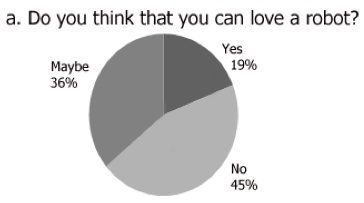‘Lovotics’: The New Science of Engineering Human, Robot Love
If you think the debates between fans of various mobile and computing platforms are tiresome, just wait until fanboys are actually, romantically in love with their devices.


Bi-directional love between a human and a robot – realistic, genuine, biologically-inspired love – is the goal of Hooman Samani, an artificial intelligence researcher at the Social Robotics Lab at the National University of Singapore. He calls this new discipline Lovotics.
Across nearly a dozen papers, he has developed a comprehensive artificial intelligence simulation of the emotional and endocrine systems underpinning love in humans, allowing his robots to be “an active participant in the communicative process, [adjusting] its affective state depending on its interactions with humans.”

Samani’s robots are equipped with both an emotional and a hormonal climate. They display a spectrum of emotions, from happiness to disgust. Based on the videos Samani has produced, they appear to experience something akin to jealousy, and are only content when being stroked by their human companions.

For simplicity’s sake, these robots resemble over-size Tribbles. They trill like R2D2, vibrate, move about and flash LED lights in order to qualify their moods.
Whether or not this work “could lead to a revolution in the way humans and robots interact and love each other,” it’s fascinating to watch a researcher pole-vault right over the question of whether or not humans can ever accept robots into the realm of whether or not we will find them as indispensable as pets, friends and – dare we say it – lovers.

Keep Reading
Most Popular
Large language models can do jaw-dropping things. But nobody knows exactly why.
And that's a problem. Figuring it out is one of the biggest scientific puzzles of our time and a crucial step towards controlling more powerful future models.
How scientists traced a mysterious covid case back to six toilets
When wastewater surveillance turns into a hunt for a single infected individual, the ethics get tricky.
The problem with plug-in hybrids? Their drivers.
Plug-in hybrids are often sold as a transition to EVs, but new data from Europe shows we’re still underestimating the emissions they produce.
Stay connected
Get the latest updates from
MIT Technology Review
Discover special offers, top stories, upcoming events, and more.